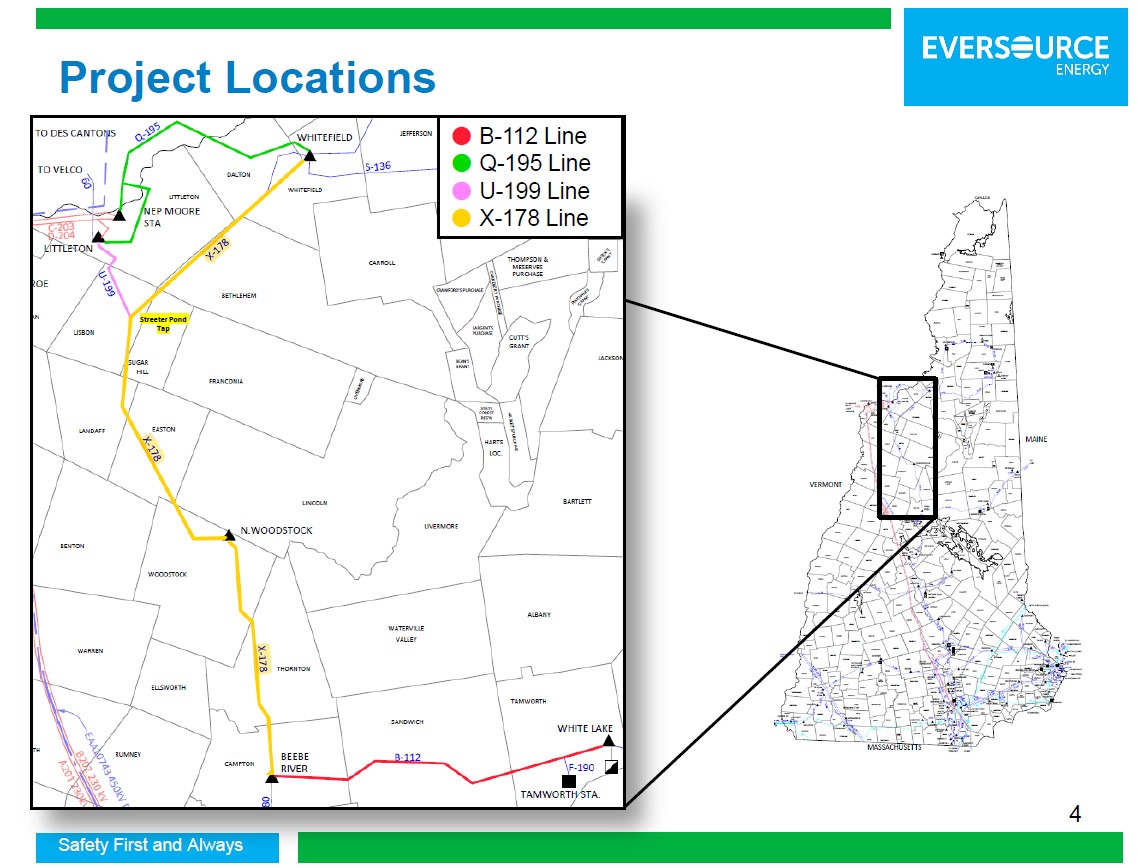Power to the People is a column by Donald M. Kreis, New Hampshire’s Consumer Advocate. Kreis and his staff of four represent the interests of residential utility customers before the NH Public Utilities Commission and elsewhere.

By DONALD M. KREIS, Power to the People
When Liberty wanted to spend $400 million a few years ago on a big project to beef up its natural gas system in southern New Hampshire, all hell broke loose. Now, Eversource wants to spend $400 million in Grafton and Coos Counties and seems to be hoping nobody, or almost nobody, will notice.
Well, we’ve noticed. “We” in this instance is not just the Office of the Consumer Advocate, but also our counterparts from around the region.
At issue is Eversource’s X-178 transmission line, which runs for 49 miles from Campton to Whitefield. And, yes, the line slices through the White Mountain National Forest for 12 of those miles.
But, no, this isn’t Northern Pass. That famously failed project was to be a new transmission line; the X-178 line already exists and Eversource is merely planning to rebuild it.
Nor is this the Twin States Clean Energy Link, which the mega-utility National Grid was planning to build in its north-south transmission corridor just a few miles to the west. Despite the promise of free federal money from the Biden Administration to pay a substantial portion of the cost, Grid pulled the plug on Twin States on March 4.
Northern Pass and Twin States prove how difficult it is to build new transmission projects and make money in the process. But why try that when you can make big bucks by beefing up existing transmission lines with little if any skeptical scrutiny?
Here’s a bit of what Eversource is hoping nobody will notice about its X-178 project.
According to Eversource, the entire line needs replacement because the average age of its poles and wires is 49 years. The region’s biggest transmission owner is tired of battling woodpeckers and nature’s other agents of entropy and wants to replace 581 wooden poles with structures made of metal.
Of course technology has changed a lot since the first part of this line, between Beebe River and North Woodstock, was deployed way back in 1948. But when it comes to embracing new technology, Eversource has been oddly selective.
On the one hand, Eversource plans to stick with traditional transmission wire with a steel core. It has declined to employ advanced conductor technology that would cost less, sag less, and require fewer transmission poles.
On the other hand, a key feature of the proposed X-178 project is replacing the shield wires – the ones at the tippy-top that help protect transmission lines from lightning – with what is known in the trade as “OPGW” – optical ground wire, which includes fiber-optic components that would give Eversource what it calls a “private, controlled, and secure high-speed data transfer and communications path that is essential for a variety of uses.”
Translation: When confronted with choices, Eversource tends to pick the more expensive option.
From a ratepayer perspective, this is not necessarily a bad thing. Utilities are supposed to make prudent investments, which means spending money wisely, given that it will ultimately be recovered – with a return on investment – from customers.
The problem is that this is a so-called “asset condition” transmission project, subject to regulation for prudence at the federal rather than the state level. And under the process the Federal Energy Regulatory Commission (FERC) has blessed for reviewing such projects in New England, there is lots of chatter among the utility and stakeholders but no straight-up review for prudence.
FERC Commissioner Mark Christie, former chair of the state utility commission in Virginia, thinks that states should step up here by providing a more muscular review of siting decisions. Transmission rates are subject to federal regulation but it is still up to each state to decide where its transmission facilities are located.
In New Hampshire, that would be the bailiwick of the Site Evaluation Committee (SEC) – the very body that nixed Northern Pass. But unlike Northern Pass, the X-178 rebuild project is unlikely to come before the SEC.
How’s that? Because the Site Evaluation Committee is not required to review transmission lines being built in existing rights-of-way as long as they will operate at 200 kilovolts or less. Eversource plans to keep this line at its current rating of 115 kilovolts.
The Site Evaluation Committee could review the X-178 project – but only upon request. Obviously, no such request will be forthcoming from Eversource. Who else is authorized to seek SEC review of this project?
That, according to RSA 162-H:2, XI, would be at least 100 registered voters in one or more of the project’s host communities, at least 100 registered voters in one or more communities that abuts the project, the governing body of a host community, or the governing bodies of two host communities. It’s something to be considered in the towns of Campton, Thornton, Woodstock, Lincoln, Easton, Landaff, Sugar Hill, Lisbon, Littletown, Bethlehem, Dalton, Whitefield and, perhaps, others nearby (depending on what you think “abutting communities” means).
Spoiler alert! Even assuming that such a petition for review is filed with the SEC, and even assuming the SEC agrees to consider the X-178 project, it is still unlikely that any of this would result in scrutinizing the prudence of spending $400 million on this project.
The approval criteria the SEC uses make no reference to what the project would cost. The only possible exception is the amorphous requirement that the SEC determine that authorizing the project would “serve the public interest.” Eversource, which surely knows how to litigate SEC issues, can be counted on to argue that this criterion does not cover prudence.
Unlike the $400 million Granite Bridge pipeline-and-tank project that Liberty Utilities canceled four year ago, the cost of Eversource’s X-178 redo would (in utility parlance) be ‘socialized’ around the region. That means the cost of this project would turn up in utility bills from Greenwich in Connecticut to Lubec in far downeast Maine.
So, given that New Hampshire is only about ten percent of the electricity load in New England, it’s fair to say that only ten percent of the X-178 upgrade would be paid for by Granite Staters. Will we, at the Office of the Consumer Advocate, succumb to moral hazard and throw up our hands, happy to export 90 percent of the cost to ratepayers in other jurisdictions?
No, we will not. Asset condition projects are out of control. If the X-178 project becomes the poster child for runaway transmission spending, and finally someone finds a way to start scrutinizing billions and billions in asset condition spending around New England, that will be very good for our state’s residential utility customers – whose interests we represent.
Meanwhile, let’s recap the bidding. According to Eversource, the problem on the X-178 line is “woodpecker damage, pole top rot, cracked arms, split pole top[s], and delay.” How many of these structures have this problem, of the 580 the company wants to replace?
The answer is 41 – or, about 7 percent. How could it possibly be prudent to spend $400 million replacing nearly 600 structures when only seven percent of them truly need replacement?
Beats the heck out of me.





